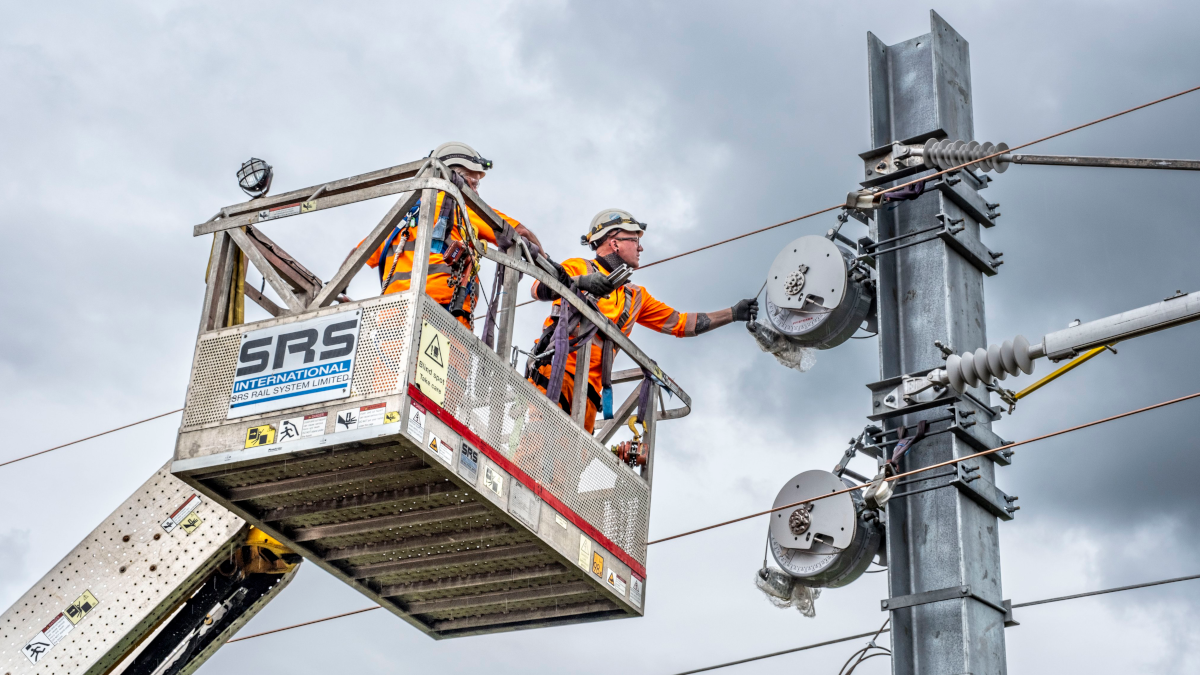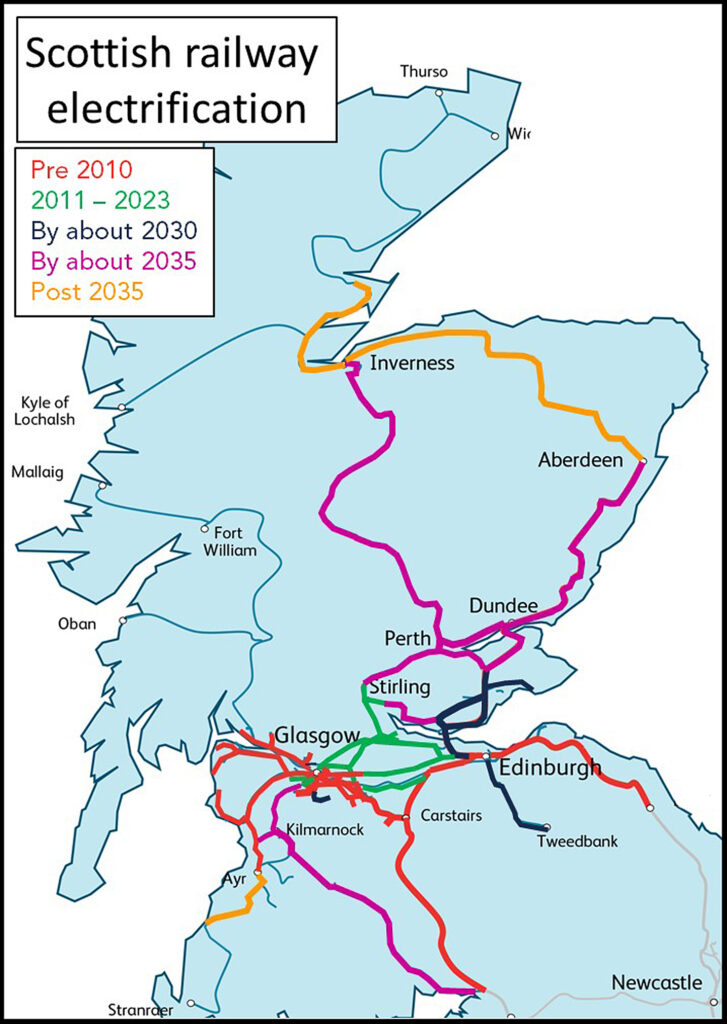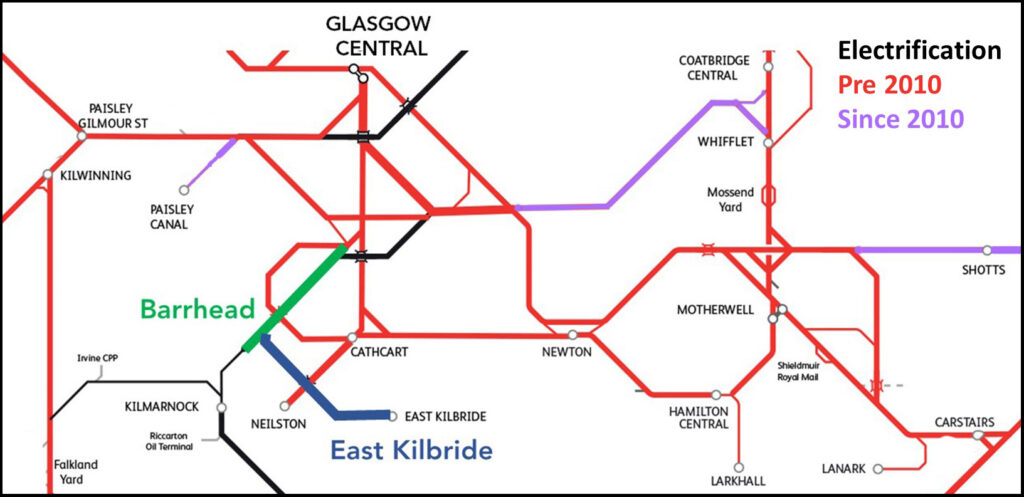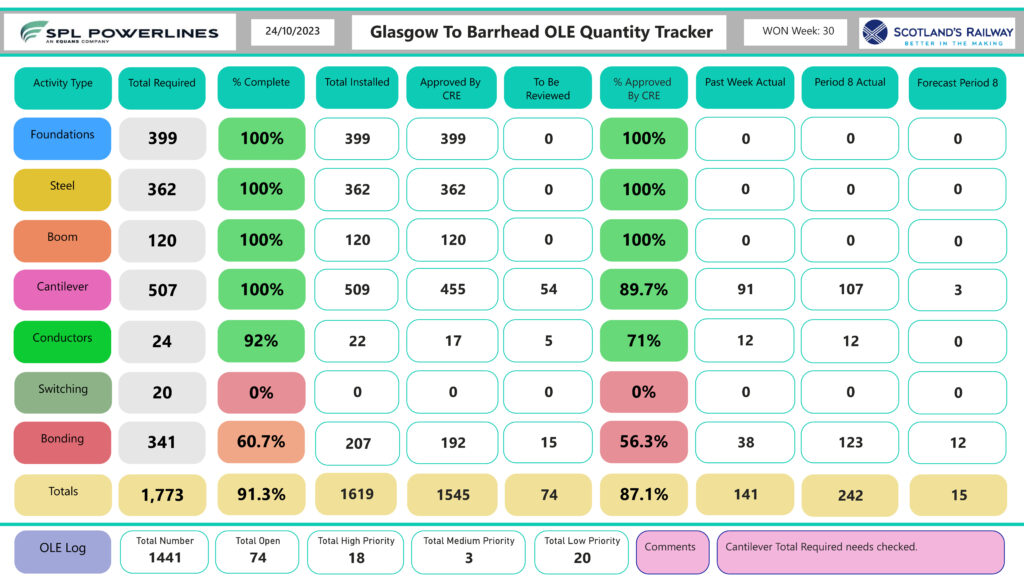Infra
Electrifying Scotland – Rail Engineer

The Airdrie to Bathgate (A2B) project, which opened in 2010, included 108 single track kilometres (stk) of electrification. This new Scottish line was the first substantial UK electrification project since the Paddington to Heathrow Express electrification in 1997. As well as A2B, major electrification projects including those on Great Western and in the North West, have added a further 1,965 stk to the electrified network since 2010.
Of this, 568 stk were new electrified lines in central Scotland which were electrified as part of an ongoing programme which has now become part of the Scottish Government’s Rail Services Decarbonisation Action Plan, which was published in July 2021. This commits to the removal of diesel passenger trains by 2035 by a 1,616 stk electrification programme. There is no Government plan to decarbonise railways in England where electrification is essentially stalled, in large part due to the excessive costs of the Great Western and other schemes.
SPL Powerlines
The two last Scottish electrification schemes were delivered by SPL Powerlines. The 75-stk electrification between Holytown and Mid Calder junctions via Shotts was energised in March 2019 to provide Scotland with a fourth electrified route between Glasgow and Edinburgh. The contracts for this scheme, and the Bedford to Corby electrification, had been let to a joint venture, Carillion Powerlines. When Carillion collapsed, the Austrian-based Powerlines Group acquired Carillion’s 50% shareholding and transferred their employees to its UK subsidiary, SPL Powerlines UK.
SPL Powerlines also recently delivered the 27 stk Muirhouse junction to Barrhead electrification as part of its Scottish electrification framework contract. This work started in April 2022 and was completed in November 2023.

The company also supported the recent large-scale remodelling of Carstairs junction which demanded a high level of discipline integration and involved the replacement of over 22km of wiring as part of the modernisation works. In addition, the company has been involved with the Levenmouth branch reconnected project which was originally to be electrified as the line was rebuilt. However, due to a pause in the electrification programme, the new line has only been built with foundations ready for future electrification.
In July 2022, it also was announced that the company had been awarded a contract for the initial phase of work of a £120 million investment to provide six new feeder traction power stations and upgrade a further nine existing feeder stations in South Glasgow, Edinburgh, Scottish Borders, and Fife.
Efficient electrification
Rail Engineer was glad of the opportunity to speak to SPL Powerline’s Scottish Regional Director, Lee Pounder to learn how electrification is being delivered in Scotland. Lee is clearly driven by the need to reduce electrification costs and advises that in Control Period 5, electrification was delivered at £2.7 million / stk and that the target of £2 million / stk for CP6 requires a 26% efficiency saving. The aspiration through CP7 is to reduce this further however volume and a rolling programme is critical to this being achieved.
In Scotland, electrification is delivered by a hub and spoke model with Network Rail at the centre managing its Civil, Signalling and Permanent way framework contractors. Lee feels that this is a mature model with mature regional relationships which works well in Scotland. He considers that effective collaborative working makes a big difference, with SPL Powerlines sharing its office with Network Rail as they deliver as one electrification delivery team.
Lee also considers that the way Network Rail Scotland is taking a long-term view offers significant benefits. The new Levenmouth branch has a detailed electrification design and foundations already installed which will significantly reduce the cost and disruption of its eventual electrification. Installing and upgrading feeder stations well in advance of electrification is also the right thing to do as power supplies are long lead items.
The collaboration between Network Rail Scotland and ScotRail also enables engineering access to be optimised. As an example, extended engineering access between 24 June to 4 August provided efficiency benefits for both electrification work and the significant platform and civils work at stations.
Specific initiatives
SPL Powerlines UK has successfully adopted a new methodology of pre-dressing masts with cantilevers, return cable brackets, and identification plates whilst they lie flat on stillages. This methodology has reduced physical track access requirements by around 75%, improved the quality of the asset that is installed on site, and acted whilst improving the safety culture by reducing the need to work at height. During the Barrhead electrification this methodology was successfully implemented at the site compound at Nitshill. This approach requires considerate planning to ensure the prefabrication and installation runs seamlessly.
SPL Powerlines UK has also invested in a Zeck wiring unit which can complete tensioned wire runs in a single shift. This unit can be configured to run both contact and catenary wires at the same time at full tension, as well as running out a conductor at the same time as recovering another. This offers greater efficiency, avoids the need to hire additional plant to load/unload drums onto trailers, and eliminates the risk of kinks, twists, and wire deformation.


Lee stressed the importance of signing off assurance documentation in real time rather than just before authorisation to avoid delays when entering the infrastructure into service. To manage this, in Scotland, SPL use Bentley’s Synchro construction management software which provides a progressive assurance database and a Power Bi dashboard to monitor progress.
Another opportunity to reduce electrification costs is increasing span length to reduce the number of masts. A recent review of the master series OLE has shown that spans of 95 metres are possible which compares with those achievable by the higher-tensioned Siemens Sicat system. Lee advised that spans of up to 80 metres had been achieved for the Haymarket to Dalmeny electrification but ultimately the mean average span would be dictated by the geometry of the track, areas of long straight railway seeing the greatest benefit.
Lee also felt that there was a further need to truly understand the below ground strata to improve the foundation delivery in all electrification schemes. Piling in areas of high rock head continues to drive programme and cost uncertainty. Innovations such as Ground Penetrating Radar and seismic wave analysis have been trialled with varied results. More development in this digital non-intrusive approach is a must.
Future electrification
In November, SPL Powerlines UK together with Story Contracting, AmcoGiffen, Siemens, Rail Systems Alliance Scotland, and WSP secured contracts totalling £61.5 million for the East Kilbride enhancements project which includes 22 stk of electrification. This is to be completed by the end of 2025. This is part of phase one of Scotland’s rail decarbonisation programme which also includes Fife and the Borders Line.
The plan to remove diesel trains from the Borders and Fife passenger services entails the use of Battery EMUs operating on a partially electrified network. For Fife services, this will comprise Haymarket to Dalmeny and four route sections from Thornton North Junction to Kirkcaldy, Lochgelly, Ladybank, and Leven which is 122 stk of electrification. This is an interim strategy pending full electrification to Inverness and Aberdeen.
However, whilst electrification between Haymarket and Dalmeny started in June 2022, this is currently paused pending a review of the rail services decarbonisation plan. In July, a Scottish Parliamentary question confirmed that Fife electrification development work was continuing and that its required feeder station would be operational in 2026.


The March 2023 pipeline update of Scotland’s infrastructure investment plan estimated that £907 million is to be spent decarbonising Scotland’s railway between 2021/22 and 2025/6. It also advised that this includes development of the decarbonisation plan’s phase 2 scheme between central Scotland and Aberdeen.
In September, a paper prepared by Audit Scotland advised that there are insufficient funds for Scotland’s planned £26 billion investment programme. This paper showed that, as a result, the £32 million Borders railway decarbonisation programme had been paused pending a refreshment of the decarbonisation action plan.
Also paused is the rolling stock procurement plan. Of its current fleet of 1,037 vehicles, Scotland’s Railway needs to replace 388 diesel powered vehicles to deliver its decarbonisation plan as well as 285 life-expired EMUs. It is envisaged that this will require 295 suburban and 275 regional BEMU/EMUs vehicles, as well as 125 electric inter-city vehicles. The original intention was to start procuring a new suburban train fleet in 2022 for entry into passenger service between 2027 and 2030.
Clearly, the financial climate has changed since the Scottish Government published its rail services decarbonisation plan in July 2020. Yet the plan recognises the need to remain flexible to take account of funding availability and emerging electrification costs. Whether the refreshed plan will be able to meet its original target of removing diesel powered passenger trains by 2035 remains to be seen.
What is clear is that the plan will still set out the overwhelming case for electrification which offers not just decarbonisation but trains that are cheaper to build and operate with improved reliability and performance. No doubt, the Scottish electrification programme will continue, albeit at a slower pace than originally intended.
Image credit: Network Rail / David Shirres / SPL Powerlines







